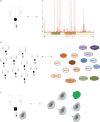De novo mutations in neurological and psychiatric disorders: effects, diagnosis and prevention
- PMID: 23009675
- PMCID: PMC3580441
- DOI: 10.1186/gm372
De novo mutations in neurological and psychiatric disorders: effects, diagnosis and prevention
Abstract
Neurological and psychiatric disorders account for a considerable proportion of the global disease burden. Although there is a high heritability and a significant genetic component in these disorders, the genetic cause of most cases has yet to be identified. Advances in DNA sequencing allowing the analysis of the whole human genome in a single experiment have led to an acceleration of the discovery of the genetic factors associated with human disease. Recent studies using these platforms have highlighted the important role of de novo mutations in neurological and psychiatric disorders. These findings have opened new avenues into the understanding of genetic disease mechanisms. These discoveries, combined with the increasing ease with which we can sequence the human genome, have important implications for diagnosis, prevention and treatment. Here, we present an overview of the recent discovery of de novo mutations using key examples of neurological and psychiatric disorders. We also discuss the impact of technological developments on diagnosis and prevention.
Figures

References
-
- Organisation mondiale de al Santé. http://www.who.int/fr/
-
- Hamdan FF, Gauthier J, Spiegelman D, Noreau A, Yang Y, Pellerin S, Dobrzeniecka S, Côté M, Perreau-Linck E, Carmant L, D'Anjou G, Fombonne E, Addington AM, Rapoport JL, Delisi LE, Krebs MO, Mouaffak F, Joober R, Mottron L, Drapeau P, Marineau C, Lafrenière RG, Lacaille JC, Rouleau GA, Michaud JL. Synapse to Disease Group. Mutations in SYNGAP1 in autosomal nonsyndromic mental retardation. N Engl J Med. 2009;360:599–605. doi: 10.1056/NEJMoa0805392. - DOI - PMC - PubMed
-
- Hamdan FF, Gauthier J, Araki Y, Lin DT, Yoshizawa Y, Higashi K, Park AR, Spiegelman D, Dobrzeniecka S, Piton A, Tomitori H, Daoud H, Massicotte C, Henrion E, Diallo O. S2D Group. Shekarabi M, Marineau C, Shevell M, Maranda B, Mitchell G, Nadeau A, D'Anjou G, Vanasse M, Srour M, Lafrenière RG, Drapeau P, Lacaille JC, Kim E, Lee JR. et al.Excess of de novo deleterious mutations in genes associated with glutamatergic systems in nonsyndromic intellectual disability. Am J Hum Genet. 2011;88:306–316. doi: 10.1016/j.ajhg.2011.02.001. - DOI - PMC - PubMed
Publication types
LinkOut - more resources
Full Text Sources

